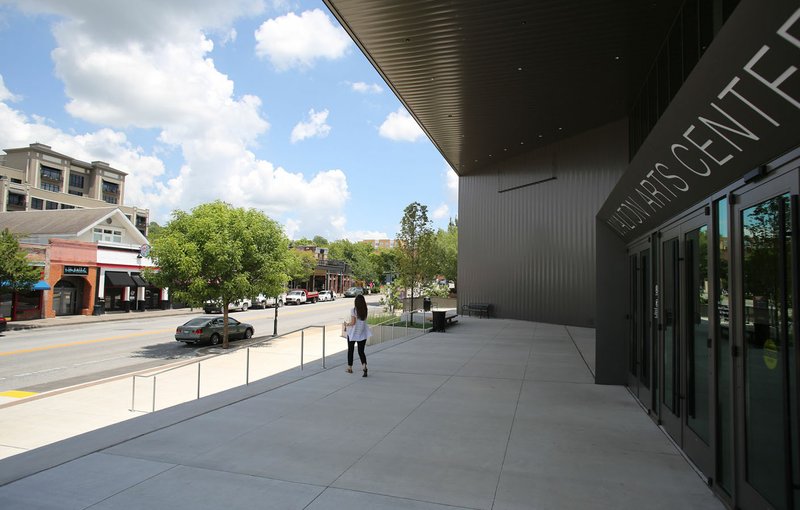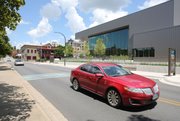FAYETTEVILLE -- Northwest Arkansas arts and culture groups draw hundreds of thousands of visitors and pump tens of millions of dollars into the region's economy, a survey has found.
Americans for the Arts, a Washington, D.C.-based nonprofit group that promotes access to the arts, pegged the economic impact of 23 regional artistic nonprofits at $131 million, or almost $300 per resident, in 2015. The spending was about evenly split between the groups' expenditures and what individuals paid for food, lodgings and so on.
The figure is a small slice of the metropolitan area's multibillion-dollar annual economy, but it also likely undercounts the tangible and intangible effect of the arts as a whole, experts and residents said last week. The report doesn't include for-profit artists and performances, s̶u̶c̶h̶ ̶a̶s̶ ̶c̶o̶n̶c̶e̶r̶t̶s̶ ̶a̶t̶ ̶t̶h̶e̶ ̶W̶a̶l̶m̶a̶r̶t̶ ̶A̶r̶k̶a̶n̶s̶a̶s̶ ̶M̶u̶s̶i̶c̶ ̶P̶a̶v̶i̶l̶i̶o̶n̶, or dozens of area nonprofit groups that didn't take part in the survey.
Nonprofit leaders said the report, above all, shows music, art and history have become an essential piece of the region's culture and well-being.
"It's not just an artsy-fartsy thing; it's something that has economic impact and a real impact on people's daily lives," said Robert Ginsburg, director of the Northwest Arkansas Jazz Society, which organizes concerts and other events and participated in the study.
The report is part of a nationwide effort to evaluate the arts' effect on about 340 cities and regions. Northwest Arkansas' numbers came from data from Crystal Bridges Museum of American Art in Bentonville, the Walton Arts Center in Fayetteville and about 20 other nonprofit groups, along with surveys of several hundred event attendees.
Those organizations drew about 1.8 million attendees in 2015, the report found, including almost half a million from outside Benton and Washington counties. Most of the outsiders surveyed said they went specifically for the art or cultural event they were attending.
Dan and Becky Ross, for example, said Thursday that they traveled from southern Missouri for the day to visit Crystal Bridges.
As they waited for it to open, a staff member mentioned the nearby Museum of Native American History, a study participant that displays arrowheads and spearheads, as well as ornaments, textiles and other artifacts from people who've lived throughout the continent for more than 10,000 years.
"We didn't even know this was here," Dan Ross said as the couple walked among the displays, adding that he was sure they'd be back in the area soon. Becky Ross said she loved Crystal Bridges' outdoor trails, calling them good places to hike with children.
Organizations the size of Crystal Bridges and the Walton Arts Center likely generate a large part of the report's findings, given each hosts hundreds of thousands of people a year, employs hundreds of residents and wields annual operating budgets on the magnitude of $20 million, according to their spokesmen.
The study used a mathematical model to estimate how much of that money is spent and changes hands multiple times within the two-county area.
The study's participants also included groups as small as the Arkansas Country Doctor Museum in Lincoln, run by one staff member and a dozen volunteers in a town of about 2,000. The museum commemorates family doctors who have set up in small towns across the state since the 1700s.
Each year, a few hundred students, former patients and other visitors go see the doctors' old-time instruments and medicines, including an iron lung and tools used during the Civil War, said Diana Hale, the museum's office manager.
"We have them from all over the world," she said, adding that people driving through will often stop by then and go to a restaurant afterward.
Visitors to Northwest Arkansas' nonprofit groups each spent an average of $36 per visit, the study found, not counting ticket prices. Nonresidents made up a smaller group than residents, but they have more to pay for per visit and overall spent more than $30 million, about the same as residents.
That outside money is a good sign for established organizations that want to keep growing, said Mervin Jebaraj, interim director of the University of Arkansas Center for Business and Economic Research.
"You want to tap out your local market, but you also want to grow your ability to get revenues," he said.
Arts and cultural groups also bring more intangible benefits to the region, Jebaraj and others said. Northwest Arkansas has exceptionally low unemployment and is home to international companies. A vibrant cultural scene makes it easier to recruit people, particularly those in their 20s and 30s, to fill those companies' jobs, Jebaraj said.
"We couldn't do what we do without it -- I'll say it's that important," said Mike Harvey, chief operating officer of the Northwest Arkansas Council, a nonprofit group that aims to help grow the area's workforce.
While not having museums and music of a certain caliber might not be the deal-breaker for a given job candidate, he said, "if it's absent, it's glaring."
Arts groups also point to the inherent value of art and history. Jennifer Wilson, a spokesman for the Walton Arts Center, said performances can help the audience relate to other cultures and overcome differences.
It can also help people connect with their own culture.
"You don't know how many people are looking for their heritage," said Charlotte Buchanan-Yale, director of the Native American museum in Bentonville. The U.S. forced tribes to move through Arkansas on their way to Oklahoma, and some of the museum's 35,000 or so yearly visitors are their descendants.
The financial and artistic benefits of Northwest Arkansas' arts and culture nonprofit organizations aren't evenly spread.
Half the groups are clustered in Fayetteville and Bentonville, for example, according to a list of almost 100 organizations that were eligible for the study provided by the Walton Arts Center, which carried out the study's surveys.
Surveys found visitors tended to be older and more educated, with most having at least a bachelor's degree and a household income above $60,000.
People of all income levels take can advantage of the area's offerings, but the lower someone's income, the less likely they are to use even free amenities, a Walton Family Foundation quality-of-life survey found last year. Low-income families might find their travel limited by having only one vehicle, for instance, or have limited free time because they work multiple jobs.
"Amenities like building a mountain bike trail system -- it's not for people who are struggling to make ends meet," Kevin Fitzpatrick, a university sociology professor who researches homelessness in the area, said last year.
On the other hand, many nonprofit groups provide events free of charge or at low cost to thousands of students on field trips. They're also adding more events and services, often with millions of dollars in charitable and public support.
"We're really lucky here," Ginsburg said.
Metro on 07/16/2017
*CORRECTION: A recent study on the economic impact of arts and cultural nonprofits included the spending generated by concerts and events at the Walmart Arkansas Music Pavilion, which is owned and operated by the nonprofit Walton Arts Center. The information was incorrect in a previous version of this story.


